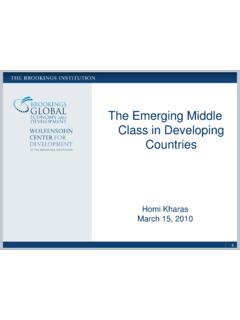Transcription of Financial Report of Ontario Universities 2015-16 …
1 Financial Report of Ontario Universities 2015 -16 highlights Council of Ontario Finance Officers May 2017. 2015 -16 COFO Report highlights Table of Contents Introduction .. 2. Revenue by Source (all funds) .. 3. Revenue by Funding .. 4. Operating Revenue .. 5. Functional Areas Operating 5. Operating Fund Expenses by Object of Expense .. 7. Sponsored Research Revenue .. 8. Enrollment .. 9. Enrollment by Region ..10. Council of Ontario Universities Page | 1. 2015 -16 COFO Report highlights Introduction The COFO Financial Report of Ontario Universities (the Report ) is prepared under the auspices of the Council of Ontario Finance Officers (COFO). The tables included in the Report have been compiled from submissions prepared by each of the publicly assisted Universities and their federated and affiliated institutions. These submissions follow the COFO Reporting Guidelines (the guidelines) that outline standards to present Financial information in a comparative and consistent manner.
2 The Financial information is prepared by major fund groups: operating, ancillary, sponsored research, trust, capital and endowment. It is recommended that the Report be reviewed in conjunction with the guidelines, including caveats and this highlights document. Both the Report and the guidelines can be downloaded from the Council of Ontario Universities (COU) website at The information presented here is at the system level (it covers all Universities and their federated and affiliated institutions), and presents comparative high-level data in the following key areas by fund and by object: revenue sources, expenditure patterns, sponsored research revenue and enrollment. Comparative data covers the last two or five years, depending on the graph. The commentary is intended to add context to the data. Note: The term fund in this document does not mean a particular type of revenue. Instead, it refers to a grouping of activities, as referred to in Fund Accounting.
3 For a list of funds, please see page 3. Council of Ontario Universities Page | 2. 2015 -16 COFO Report highlights Revenue by Source (all funds). Chart 1 presents total revenue by source in actual dollars, and as a percentage of total revenue. The largest sources of revenue over five years (2011-2012 to 2015 -2016) were Grants and Contracts, and Tuition and Miscellaneous Fees, which together account for 87. per cent of the total revenue in 2015 - 2016. Grants and Contracts, which account for 45 per cent or more of the total revenue from 2011-2012 to 2015 -2016, consist primarily of operating grants from the Ministry of Advanced Education and Skills Development (MAESD) and from federal, provincial and other research grants, as well as various research contracts. Investment Income as a percentage of total revenue dropped to per cent for 2015 -2016. Donations from individuals, corporations and foundations remained relatively constant at 4 per cent to 5 per cent of the total revenue over the five years.
4 Other Revenue, which includes primarily external sales of goods and services and application fees, was 8 percent of total revenue in 2015 -2016, from a high of 10 per cent in 2011-12. CHART 1: Total Revenue by Source (all funds) ($ millions). $7,000 51% 47% 45% 47%. 45%. $6,000 40%. 37%. 35%. $5,000 34%. 33%. $4,000. $3,000. $2,000. 10% 9% 8% 8% 7% 7% 8%. 6%. $1,000 4% 4% 4% 4% 5%. 2%. 0%. $0. 2011-2012 2012-2013 2013-2014 2014- 2015 2015 -2016. Grants and Contracts Tuition and Miscellaneous Fees Investment Income Donations Other Revenue Council of Ontario Universities Page | 3. 2015 -16 COFO Report highlights Revenue by Funding Chart 2 shows both the revenue received by fund and its percentage of the total revenue over five years (2011-2012 to 2015 -2016). The chart reflects different types of funds: The Operating Fund includes student tuition fees, operating grants and other general unrestricted revenue. The Ancillary Fund accounts for revenues generated by operations such as bookstores, food services, residences and parking.
5 The Trust Fund accounts for expendable designated gifts, benefactions, grants and interest earned on non-expendable gifts, which must be spent in accordance with specific instructions by the donors or by internal restriction by the university's governing body. The Capital Fund includes grants, donations and other funds made available to the university by external funding sources (such as government and donors), specifically for capital purposes. The Sponsored Research Fund includes government, private industry and donor funding provided specifically for sponsored research. The Endowment Fund accounts for the capitalization of externally or internally restricted gifts which cannot be spent. CHART 2: Total Revenue by Fund- ($ millions). $10,000 67%. 63%. 62%. $9,000 61%. 62%. $8,000. $7,000. $6,000. $5,000. $4,000. 21% 21% 19% 18% 19%. $3,000. $2,000 7% 7% 7%. 7%. 7% 6% 4% 5% 4% 4%. $1,000 4% 4% 3% 4% 5%. 3% 3% 4%.
6 0% -1%. $0. 2011-2012 2012-2013 2013-2014 2014- 2015 2015 -2016. -$1,000. Operating Ancillary Trust Capital Sponsored Research Endowment Council of Ontario Universities Page | 4. 2015 -16 COFO Report highlights Operating Revenue Chart 3 presents the major sources of revenue accounted for in the Operating Fund in actual dollars and as a percentage of the total revenue over five years (2011-2012 to 2015 -2016). The two largest sources, accounting for more than 90 per cent of the total, are operating grants from the Ministry of Advanced Education and Skills Development (MAESD) and tuition fee revenue. Operating grants increased in dollar terms over the five-year period, primarily because operating grants are determined on the basis of enrollment. Despite continued annual significant increases in enrollment (both undergraduate and graduate), operating grants continues to decline relative to other sources of revenue. Tuition fees for domestic students attending Ontario publicly assisted Universities are regulated by MAESD's tuition framework.
7 Under this framework, tuition fees are permitted to increase by an overall average of 3 per cent per year for 2013-2014 to 2016-2017, with variations in allowable increases for different types of programs and for students in different years of their Tuition fee revenue increased in dollar terms and as a percentage of the total revenue over the five years, mainly as a result of enrollment growth and related fee increases during that period. On a relative basis Universities are relying more and more over time on tuition revenue versus government grants. Other revenue represented 6 per cent or less of the total revenue, and included investment income and other miscellaneous items, such as application fees. CHART 3: Operating Revenue by Source- ($ millions). 6,000. 56%. 54%. 5,000 52%. 51%. 46% 50% 43% 42% 41% 40%. 4,000. 3,000. 2,000. 1,000 4% 6% 6% 5% 4%. 0. 2011-2012 2012-2013 2013-2014 2014- 2015 2015 -2016. Grants and Contracts Tuition and Miscellaneous Fees Other Revenue 1.
8 Ontario 's tuition framework from 2013-14 to 2016-17 allowed tuition rate increases of 3% for students in most undergraduate programs, 5% increases for entering students in professional and graduate programs, and 4% increases for professional and graduate students who started their studies under the previous framework until their graduation. The average of these rate increases, weighted by enrollment in programs, cannot exceed 3%. Council of Ontario Universities Page | 5. 2015 -16 COFO Report highlights Functional Areas Operating Fund Chart 4 presents expenses by major functional areas reported in the Operating Fund. The information is presented in both dollars and percentages for a two-year period (2014- 2015 . and 2015 -2016). In 2015 - 2016, 58 per cent of expenses in the Operating Fund were incurred on Instruction and Research. The majority of these funds were allocated directly to the academic units for the pursuit of teaching and research.
9 All other functional areas supported the infrastructure necessary to advance the academic mission of Ontario Universities . The amount of spending in the Physical Plant area demonstrates the significant investment requirements to support and maintain campus buildings, grounds and utilities. However, provincial funding did not meet generally recognized benchmarks for investments in capital maintenance. As outlined in the Ontario Universities ' Facilities Condition Assessment Program June 2015 , the generally accepted minimum industry standard of re-investment in building renewal is of the Current Replacement Value (CRV). By comparison, the funding level under the provincial government's Facilities Renewal Program from 2010-11 to 2014-15. was$ million annually representing of CRV. In 2015 -16, the funding level increased to $ million per year, which represents of CRV. The major components of expenditures incurred in Student Services were scholarships and bursaries.
10 For a more detailed explanation of each functional area, please refer to the COFO Reporting Guidelines at CHART 4: Operating Fund Expenses by Functional Area*- ($ millions). Total for 2015 -2016: $8,908 (Total for 2014- 2015 : $8,426). Physical Plant, $854, 10% External Relations, Administration ($753, 9%) $210, 2%. and General, ($204, 2%). $403, 5%. ($392, 5%). Central Computing and Communications, $266, 3%. ($273, 3%). Student Services, $1,069, 12%. ($1,017, 12%). Library, $363, 4%. ($338, 4%) Instruction and Research, Academic Support, $5,181, 58%. $562, 6% ($4,981, 59%). ($468, 6%). (*figures in brackets pertain to 2014- 2015 ). Council of Ontario Universities Page | 6. 2015 -16 COFO Report highlights Operating Fund Expenses by Object of Expense Chart 5 presents expenses by objects of expenses reported in the Operating Fund. The data is presented in both dollars and percentages for a two-year period (2014- 2015 and 2015 -2016).






